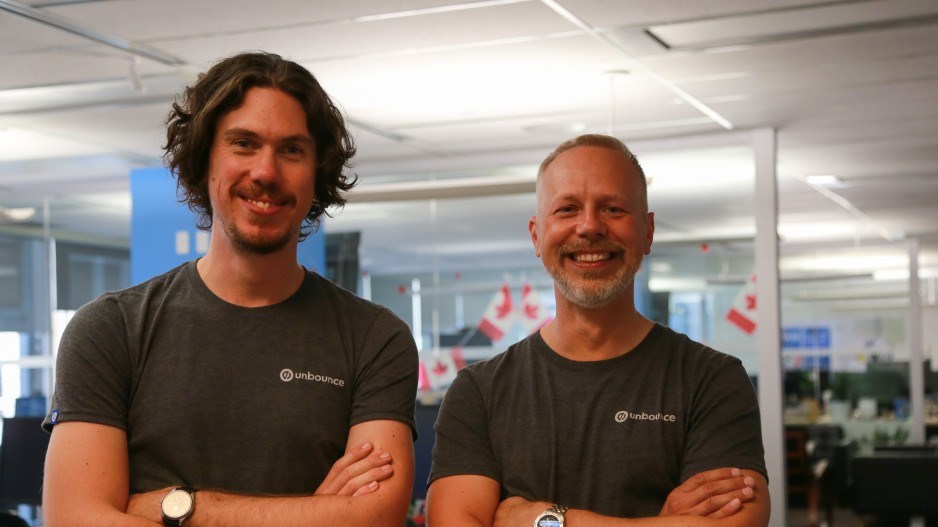Sometimes the more things change, the more they stay the same. When Vancouver-based Unbounce was founded 10 years ago, the company set out to provide marketers with a drag-and-drop landing page development platform that didn’t require them to invest as much in information technology development, engineering and design.
“Today that’s still more or less what we do,” Unbounce president and co-founder Carter Gilchrist told Business in Vancouver. “There’s just been a lot of change in the marketing technology landscape.”
Unbounce provides marketers with a platform that lets them develop and publish landing pages without requiring them to invest in their own web developers. It has also begun to use artificial intelligence (AI) to offer its clients insights and automation that will allow them to optimize their campaigns and improve their return on investment.
Starting in 2009 as a six-person operation in Gastown, Unbounce now employs 182 people across two offices, in Vancouver and Berlin, and counts 15,000 customers worldwide, including The New York Times, Hootsuite, and the Red Cross.
Between 2014 and 2018, its revenue grew by 490.7%, reaching over $23.3 million last year and earning it the No. 15 spot on this year’s Business in Vancouver list of the top 100 fastest-growing companies in British Columbia. The company has also been recognized by Deloitte as one of Canada’s Technology Fast 50 in 2016, 2017 and 2018.
Being able to witness a decade’s worth of changes in its industry has made Unbounce part of a small and exclusive club: according to research conducted by OpenX, a U.S. ad tech firm, the average lifespan of a company in this sector is just six years, with fewer than 5% surviving past 10 years.
This longevity hasn’t come without growing pains. In 2017, Unbounce decided to close its Montreal office, under pressure from payments on around $4.5 million of debt and a squeezing of its profits due to foreign exchange rate fluctuations.
“That led us to have to make a really tough call, and to really reevaluate how we were running the business, what we were doing, and what we learned out of that,” Gilchrist said, emphasizing that the company’s revenues didn’t stop growing and that it is now on track to reach a $2 million profit by the end of 2019.
This reevaluation led to the recent reveal of Unbounce’s new visual identity and corporate vision, emphasizing a more human-centric approach and a commitment to provide small and medium-sized businesses (SMBs) improved marketing solutions by leveraging the power of AI.
Last year Unbounce conducted an eight-week pilot project that used machine learning to help marketers optimize their campaigns and increase conversion rates, and the company plans that the first wave of products derived from its AI technology will be launched by the end of 2019.
According to Salesforce Research, only 11% of SMBs use AI, and 41% feel it’s too complex for their needs, but 51% of them believe AI is an important factor when choosing new technologies.
Additionally, research conducted by Software Advice has found that 65% of SMBs are still using simple spreadsheets for data analysis, with 53% of them admitting that budget constraints are the reason they aren’t upgrading to AI-powered technology.
“For us, we think that’s a huge opportunity, because we’ve focused on helping our customers grow their businesses using AI-based tools,” said Unbounce co-founder and CTO Carl Schmidt.
“We think that the big shift now is going to be helping to educate the market and helping to fill in that huge gap of companies that don’t understand how to use AI in their businesses.”
However, Schmidt acknowledged that increasing AI adoption rates isn’t just about budgets or about technological benefits or capabilities.
“We’ve got great technology, and we can actually do a lot now in terms of teaching machines what works and what doesn’t and how to get you better results. This is now a trust issue. How do we get our customers to trust that machines aren’t scary, particularly to jobs, that they can do a good job for them, that they can make them more money,” he said.
Gilchrist noted a demographic shift that may soon turn the tide for AI – by 2025, millennials are expected to make up 75% of the global workforce, and to own a significant share of the SMB space.
“That generation is really a lot more open to risk. They want to use the right tool for the job, and they were early adopters of technology,” Gilchrist said. “And tools like us can help you connect the dots between what seemed to be an unachievable goal that you can now do on your own and get the results that you would expect.”




